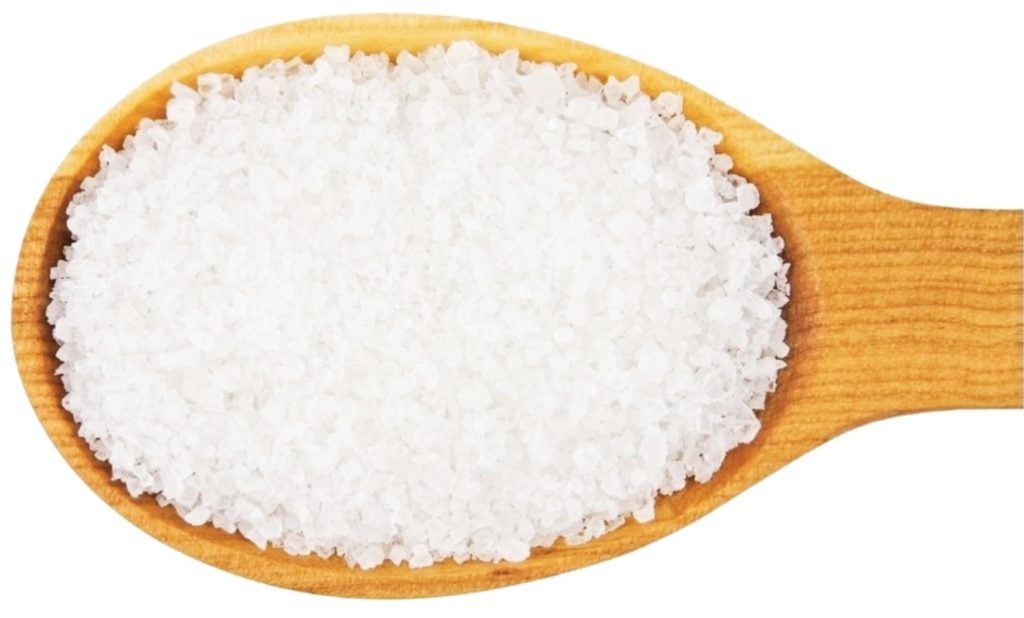
From restaurants to supermarkets, the food industry is under increasing pressure to reduce the sodium content in the products they prepare and sell. From farming and R&D departments – right down to the consumer salt shakers – that’s clear acrosss upply chains. Fundamentally, this is due to the health dangers that consuming too much sodium can cause, notably rising blood pressure and heart failure. Yet though 64% of consumers are now aware of high-sodium health implications, only 37% actually pay attention to how much they consume. Even worse, roughly 75-80% of the salt we consume is actually ‘hidden’ salt added before consumers even buy the food.
37%
Consumers that actually pay attention to how much sodium they consume.
SALTS survey
This is not helped by voluntary regulation and guidance that surround sodium intake levels in many countries. In 2003, for instance, the UK launched a pioneering voluntary salt reduction programme. At first, the scheme was successful: average salt intake initially declined from 9.38g/day to 7.58g/day, cutting blood pressure and strokes along the way. Since the food industry took over the voluntary policy in 2014, however, the programme has been less effective – with research by Queen Mary University of London (QMUL) seeing declines in sodium intakes falter. Despite this, the initial success of the sodium scheme points to the potential of salt reduction programmes, with Action on Salt finding that 85% of Brits support government action forcing companies to cut unnecessary salt from their products, according to a poll by the group.
75%
Percentage of PepsiCo global food portfolio that aims to meet – or beat – category sodium targets by 2030.
PepsiCo
Worth the salt?
With increasing enthusiasm for sodium reduction, what options are there to keep consumers’ palates happy – while also improving their health? One option is to reduce salt intake gradually. As Sonia Pombo, a research fellow and Campaign Lead at Action on Salt explains, this often leads to longerterm benefits for companies and consumers. “Our preferred approach would be those slow reductions where possible, not having to use salt replacement because what we’re also trying to do is try and get people’s preferences for that salty taste to go down as well,” she says. “Whereas if you’re always trying to maintain that salty hit time after time, you’re going to reach a point where you can’t reduce things.”
But with a lack of compulsory targets and guidelines for companies to follow, how can the necessary reductions be encouraged? At Action on Salt, Pombo and her colleagues work to promote salt reduction by meeting with government bodies regularly, providing them with evidence for the benefits of sodium reduction, while also monitoring food companies regularly to find out the feasibility of salt reduction in different products and pushing stronger monitoring and targets.
“Our preferred approach would be… slow reductions where possible, not having to use salt replacement because what we’re also trying to do is try and get people’s preferences for that salty taste to go down as well.”
Sonia Pombo
This is not to say that companies aren’t keen to meet consumer demands themselves. For instance, PepsiCo recently announced its aim for 75% of its global food portfolio to meet – or be below – category sodium targets by 2030. “We set new 2030 sodium and diverse ingredient goals to help be a catalyst for change in the industry and help address ongoing public health concerns of excess sodium intake and low consumption of food groups and ingredients that are important sources of nutrition,” explains René Lammers, the multinational’s chief scientific officer. “We’ll aim to meet these nutrition ambitions through a combination of current offerings, reformulation of our existing products and innovation to come up with new ones.”
With several products already meeting these targets, PepsiCo offers low-sodium options across the globe, from its Lightly Salted Lay’s chips (USA), Sabritas salted potato chips (Mexico), and lowsodium corn chips (Australia). In an effort to reduce the sodium levels across their product offerings, PepsiCo starts this process right at R&D, ensuring ingredients offer the best possible flavours to the kitchen – where, in turn, experts study salt crystal size, shape and formulation to cut sodium levels.
Another option is exploring sodium alternatives, which replace salt with a healthier alternative. One option here is potassium chloride. A naturally occurring mineral salt, similar to sodium chloride, potassium nonetheless has the opposite effect, cutting the hypertension commonly associated with regular salt. The switch to potassium also has the added benefit of helping to meet WHO dietary guidelines. But switching out sodium for potassium isn’t as simple as it sounds, as companies have to consider taste, texture and smell when changing a popular recipe. Even worse, potassium chloride can only be used in limited quantities before it stops conveying the intended saltiness – and instead leaves a bitter taste. This inevitably means that R&D often turn to bitter blockers, flavour modulators or synthetic additives. As Pombo points out, this can in turn cause labelling issues: “I believe a lot of companies are quite hesitant to use that because it doesn’t give to you things like clean labelling.”
Potassium is not the only sodium alternative, with some insiders positing MSG as a potential option. And why not? Offering up to two-thirds of the sodium levels of regular salt – but still enhancing flavour enhancement – MSG is growing in popularity with the US market expecting a CAGR growth of 4.09% over the next five years. Another alternative making waves is MicroSalt, a 100% natural salt alternative that is relatively new to the market – but which is nonetheless taking the sodium sector by storm thanks to its unique product offering. The manufacturing process produces a particle coated with nano-sized salt crystals, which delivers a salty flavour with 50% less sodium. Food developers and manufacturers are also looking beyond traditional alternatives to cut sodium levels. “I was talking to a company a few months ago about thermal processing,” Pombo says. “You use pressure cooking essentially.” Through this technique, Pombo explains, food manufacturers don’t need to use as much salt as it maintains the nutrients and flavour. A good example here is Cargill’s compacting technology, which enables sodium reduction in food while maintaining the same taste.
Cutting back
Beyond the technical issues with ingredients such as potassium chloride, cutting sodium involves other challenges. One of the main difficulties encompasses the public perception of food – consumers who are used to certain levels of saltiness will struggle with reduced sodium options before their tastebuds can adapt. “Delivering and maintaining the desired taste experience is complex and often involves rebalancing flavour and seasoning elements in addition to lowering the level of sodium in the recipe,” says Lammers. “This process requires expertise from our culinary, food science, flavour and ingredient teams. We work with expert sensory panellists trained to recognise changes in smell, taste, texture, etc. that would be indistinguishable to the average person to ensure all recipe changes will be acceptable to the consumer.” While adding less salt can taste bland, this is something your body will adapt to over time as your tastebuds start working better, Pombo adds. Salt alternatives, for their part, pose a similar problem. The texture changes associated with sodium reduction can be another frustrating challenge.
Reducing sodium, in short, is a looming task for food companies, one requiring a thoughtful balance between cutting salt and adding alternatives. PepsiCo’s new sodium targets are an ambitious step in the right direction, aiming to be 15-30% lower for convenient food categories, explains Lammers. “For example,” he continues, “Our new sodium goal aims for a 15% sodium reduction in our US product Lay’s Classic Potato Chips, which would result in a sodium level of 140mg per 28g serving.” As Lammers continues, PepsiCo is focused on controlling sodium levels in its products with guidance from public health experts and science but is aware of the complexities of the global nutrition landscape. As Pombo emphasises, gradual reduction of sodium content is the best step forward – both for achieving immediate health benefits and a more successful long-term solution.
That’s borne out by the numbers. As QMUL’s study showed in the UK, if the voluntary programme had continued as before, then over 38,000 deaths from strokes and heart disease could have been prevented – and salt intake might have been drastically reduced, too. These considerations are equally important for the long-term future health of the public. According to the British Heart Foundation, if every adult in the UK met WHO’s salt consumption guidelines by 2030, there would be 1.4 million fewer new cases of high blood pressure, 135,000 fewer new cases of coronary heart disease and up to 49,000 fewer new cases of stroke by 2035.

“Delivering and maintaining the desired taste experience is complex and often involves rebalancing flavour and seasoning elements in addition to lowering the level of sodium in the recipe.”
René Lammers
With so much on the line, therefore, then how can the food industry meet these low-sodium targets? For Pombo, the gradual reduction of sodium in our food is a key intermediate step – but mandatory guidelines and regulations are what’s really necessary. “Many companies are nowhere near achieving those targets for whatever reason,” she says, adding that’s likely down to their voluntary nature. While some companies might be keen to further their salt reduction progress, if their competitors aren’t participating, why should they? Certainly, Lammers implies as much himself. “We recognise the importance of consumer acceptability of any products we offer,” he says. “Reducing sodium in our products won’t help to reduce sodium intake if individuals switch to other higher-sodium options or add salt at the table.”
38,000
Deaths due to stroke and heart disease that could have been avoided between 2014– 2018 if the UK’s salt reduction programme had successfully continued.
QMUL
The vagaries of capitalism therefore make an industry-wide approach vital. “We hope,” Lammers adds, “that other leaders in the food and beverage space will utilise scientific knowledge and innovative solutions and set new standards for themselves and their products.”





